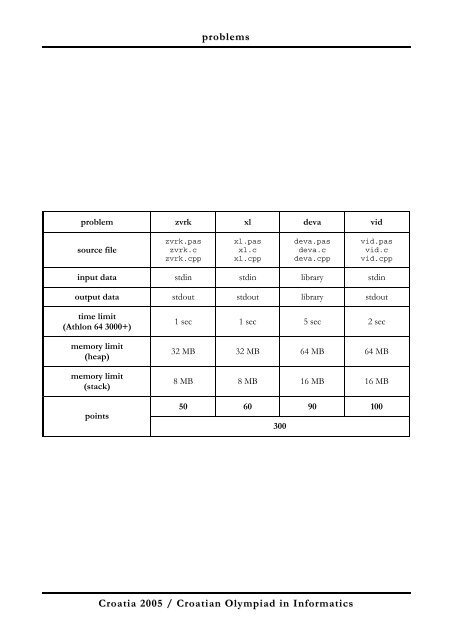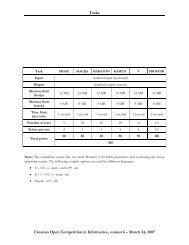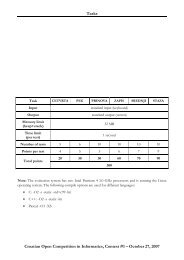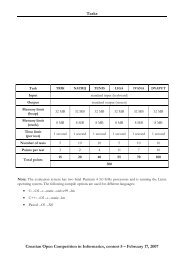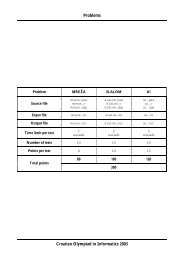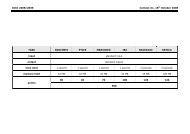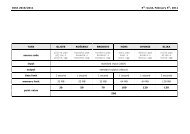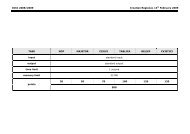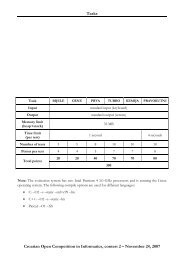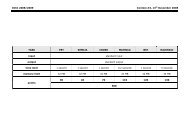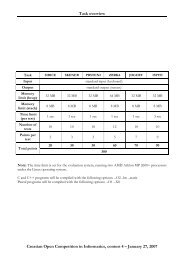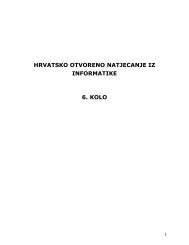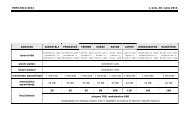Croatia 2005 / Croatian Olympiad in Informatics
Croatia 2005 / Croatian Olympiad in Informatics
Croatia 2005 / Croatian Olympiad in Informatics
You also want an ePaper? Increase the reach of your titles
YUMPU automatically turns print PDFs into web optimized ePapers that Google loves.
problems<br />
problem zvrk xl deva vid<br />
source file<br />
zvrk.pas<br />
zvrk.c<br />
zvrk.cpp<br />
xl.pas<br />
xl.c<br />
xl.cpp<br />
deva.pas<br />
deva.c<br />
deva.cpp<br />
vid.pas<br />
vid.c<br />
vid.cpp<br />
<strong>in</strong>put data std<strong>in</strong> std<strong>in</strong> library std<strong>in</strong><br />
output data stdout stdout library stdout<br />
time limit<br />
(Athlon 64 3000+)<br />
memory limit<br />
(heap)<br />
memory limit<br />
(stack)<br />
po<strong>in</strong>ts<br />
1 sec 1 sec 5 sec 2 sec<br />
32 MB 32 MB 64 MB 64 MB<br />
8 MB 8 MB 16 MB 16 MB<br />
50 60 90 100<br />
300<br />
<strong>Croatia</strong> <strong>2005</strong> / <strong>Croatia</strong>n <strong>Olympiad</strong> <strong>in</strong> <strong>Informatics</strong>
zvrk<br />
By remov<strong>in</strong>g all digits left of the rightmost digit one <strong>in</strong> the b<strong>in</strong>ary representation of some <strong>in</strong>teger,<br />
we get what is called the "zvrk" of that number.<br />
For example, the zvrk of 6 i.e. (110) 2 is 2 i.e. (10) 2 , and the zvrk of 40 i.e. (101000) 2 is 8 i.e. (1000) 2 .<br />
Write a program that will calculate the sum of the zvrks of all numbers between two given numbers<br />
A and B (<strong>in</strong>clusive).<br />
<strong>in</strong>put data<br />
First and only l<strong>in</strong>e of <strong>in</strong>put conta<strong>in</strong>s two <strong>in</strong>tegers A and B, 1 ≤ A ≤ B ≤ 10 15 .<br />
output data<br />
First and only l<strong>in</strong>e of output should conta<strong>in</strong> the sum from the problem statement.<br />
Note: the result will fit <strong>in</strong>to the 64-bit signed <strong>in</strong>teger type (<strong>in</strong>t64 <strong>in</strong> Pascal, long long <strong>in</strong> C/C++).<br />
examples<br />
<strong>in</strong>put<br />
176 177<br />
output<br />
17<br />
<strong>in</strong>put<br />
5 9<br />
output<br />
13<br />
<strong>in</strong>put<br />
25 28<br />
output<br />
8<br />
<strong>Croatia</strong> <strong>2005</strong> / <strong>Croatia</strong>n <strong>Olympiad</strong> <strong>in</strong> <strong>Informatics</strong>
xl<br />
A square consists of cells organized <strong>in</strong> N rows and N columns. Each cell is either empty or conta<strong>in</strong>s a<br />
s<strong>in</strong>gle Roman numeral (I, V, X, L, C, or D, represent<strong>in</strong>g numbers 1, 5, 10, 50, 100 and 500<br />
respectively).<br />
Look at the picture from third test example:<br />
I I X V L X<br />
X L I X V I<br />
I V I X X<br />
L I X V I X<br />
X X I X I<br />
L I V L X X<br />
V I X I X L<br />
We start at the central cell of the square (N will be odd and central cell will be empty <strong>in</strong> all test cases)<br />
and try to f<strong>in</strong>d the longest sequence of Roman numerals represent<strong>in</strong>g consecutive <strong>in</strong>tegers start<strong>in</strong>g<br />
from 1 and separated by one empty cell. A sequence is obta<strong>in</strong>ed by "walk<strong>in</strong>g" through the square so<br />
that each step consists of mov<strong>in</strong>g to an adjacent cell left, right, up or down from the current cell. Each<br />
Roman numeral (<strong>in</strong>clud<strong>in</strong>g the last one) <strong>in</strong> a sequence must end with one (and only one) empty cell <strong>in</strong> a<br />
sequence. The output of a program should be (a decimal representation of) the largest number <strong>in</strong> the<br />
sequence.<br />
Start<strong>in</strong>g with the square above we can walk up-down-up-up-left-right-down-up-left to obta<strong>in</strong> the first<br />
tree numbers <strong>in</strong> a sequence IeIIeIIIe (where e denotes empty cell).<br />
To obta<strong>in</strong> Roman representation of a number written <strong>in</strong> a decimal notation one may proceed as<br />
follows: Convert each decimal digit separately to its Roman equivalent tak<strong>in</strong>g its positional value <strong>in</strong>to<br />
account, <strong>in</strong> descend<strong>in</strong>g order by their values. E.g. 726 = 700+20+6 → DCC XX VI = DCCXXVI.<br />
There are some special cases when letters represent<strong>in</strong>g Roman numeral of lower values are written<br />
before letters represent<strong>in</strong>g Roman numeral of higher values. Special cases here are numbers 4, 9, 40, 90<br />
and 400 whose Roman numerals are obta<strong>in</strong>ed by writ<strong>in</strong>g lower numeral before higher: IV, IX, XL, XC<br />
and CD respectively. E.g. 499 = 400+90+9 = CD XC IX = CDXCIX (and not ID, as it might appear<br />
to be).<br />
Write a program that will f<strong>in</strong>d the longest sequence of Roman numerals represent<strong>in</strong>g consecutive<br />
positive <strong>in</strong>teger numbers start<strong>in</strong>g from 1 and separated by one empty cell (as described above) and<br />
write (a decimal representation of) the largest number <strong>in</strong> the sequence.<br />
<strong>Croatia</strong> <strong>2005</strong> / <strong>Croatia</strong>n <strong>Olympiad</strong> <strong>in</strong> <strong>Informatics</strong>
xl<br />
<strong>in</strong>put data<br />
First l<strong>in</strong>e of <strong>in</strong>put conta<strong>in</strong>s an odd <strong>in</strong>teger N, 1 ≤ N ≤ 99.<br />
Each of the next N l<strong>in</strong>es conta<strong>in</strong>s N characters depict<strong>in</strong>g the correspond<strong>in</strong>g row of a square us<strong>in</strong>g<br />
characters 'I', 'V', 'X', 'L', 'C', 'D' and '.' (dot, denot<strong>in</strong>g empty cell).<br />
output data<br />
First and only l<strong>in</strong>e of output should conta<strong>in</strong> the decimal representation of the last number <strong>in</strong> the<br />
longest sequence of Roman numerals as described above.<br />
examples<br />
<strong>in</strong>put<br />
3<br />
I.I<br />
I.V<br />
I..<br />
output<br />
6<br />
<strong>in</strong>put<br />
5<br />
.IV.I<br />
II.II<br />
XV.VI<br />
..I..<br />
...II<br />
output<br />
11<br />
<strong>in</strong>put<br />
7<br />
IIXV.LX<br />
XL.IXVI<br />
.IVIX.X<br />
LIX.VIX<br />
X.XIXI.<br />
LIVL.XX<br />
VI.XIXL<br />
output<br />
51<br />
<strong>Croatia</strong> <strong>2005</strong> / <strong>Croatia</strong>n <strong>Olympiad</strong> <strong>in</strong> <strong>Informatics</strong>
deva<br />
A desert conta<strong>in</strong>s N cities, 2 ≤ N ≤ 1000000 (one million). Some of them are directly connected by<br />
roads, and each city is connected directly with at most 5 other cities.<br />
Abdul and Yasser are given a list of K cities, 2 ≤ K ≤ 8, which they must visit rid<strong>in</strong>g on a camel. The<br />
cities are marked with a 1 through a K , and the camel they are rid<strong>in</strong>g can traverse at most L roads per<br />
day, 1 ≤ L ≤ 10.<br />
They have to start their journey <strong>in</strong> city a 1 and then visit and spend the night <strong>in</strong> each of the other K-1<br />
cities <strong>in</strong> exactly K days. They may visit them <strong>in</strong> any order, but return to city a 1 at the end of the trip.<br />
They may not visit any of the cities a 2 through a K more than once.<br />
However, Abdul and Yasser don’t have a map of the desert so they cannot know which cities are<br />
connected by roads, and which aren’t. But, by us<strong>in</strong>g an SMS service of the local mobile telephony<br />
provider, they can f<strong>in</strong>d out all cities which are directly connected to some city. See<strong>in</strong>g as our<br />
protagonists are on the run, their fund<strong>in</strong>g is limited and so they can send at most 5000 such SMS<br />
messages.<br />
Write a program which will help them f<strong>in</strong>d some route adher<strong>in</strong>g to the given constra<strong>in</strong>ts.<br />
library<br />
To solve the problem you will use a library (devalib) conta<strong>in</strong><strong>in</strong>g four functions.<br />
Init - needs to be called exactly once and before us<strong>in</strong>g any of the other library functions. This<br />
function returns the numbers N and L.<br />
procedure Init(var n, l : long<strong>in</strong>t);<br />
void Init(<strong>in</strong>t *n, <strong>in</strong>t *l);<br />
Gradovi - returns the number and list of cities Abdul and Yasser need to visit, a 1 through a k ,<br />
respectively.<br />
procedure Cities(var k : long<strong>in</strong>t; var listc: array of long<strong>in</strong>t);<br />
void Cities(<strong>in</strong>t *k, <strong>in</strong>t listc[]);<br />
Susjedi - simulates the send<strong>in</strong>g of one SMS message. Returns the number and list of cities connected<br />
by road to the given city city. You may call this function at most 5000 times.<br />
procedure Neighbours(city : long<strong>in</strong>t; var howmany : long<strong>in</strong>t; var neighbours:<br />
array of long<strong>in</strong>t);<br />
void Neighbours(<strong>in</strong>t city, <strong>in</strong>t *howmany, <strong>in</strong>t neighbours[]);<br />
Rjesenje - needs to be called at the end of your program. Its arguments are the cities Abdul and<br />
Yasser visited, <strong>in</strong> order. The first and last city <strong>in</strong> the list needs to be city a 1 . This function will also<br />
regularly end your program’s execution.<br />
procedure Solution(tourlength : long<strong>in</strong>t; var tour : array of long<strong>in</strong>t);<br />
void Solution(<strong>in</strong>t tourlength, <strong>in</strong>t tour[]);<br />
<strong>Croatia</strong> <strong>2005</strong> / <strong>Croatia</strong>n <strong>Olympiad</strong> <strong>in</strong> <strong>Informatics</strong>
vid<br />
N po<strong>in</strong>ts are given <strong>in</strong> a plane. Any po<strong>in</strong>t has <strong>in</strong>teger coord<strong>in</strong>ates and no two po<strong>in</strong>ts have the same x<br />
coord<strong>in</strong>ates or the same y coord<strong>in</strong>ates.<br />
A pair of po<strong>in</strong>ts A and B uniquely def<strong>in</strong>e a rectangle R(A,B) whose sides are parallel to coord<strong>in</strong>ate axes<br />
such that the po<strong>in</strong>ts A and B are endpo<strong>in</strong>ts of one of its diagonals. A pair of two given po<strong>in</strong>ts A and B<br />
are very visible if there are no other given po<strong>in</strong>ts with<strong>in</strong> a rectangle R(A,B). A pair of po<strong>in</strong>ts<br />
consists of two different po<strong>in</strong>ts and <strong>in</strong> this problem pairs (A,B) and (B,A) are regarded to be the same<br />
pair and are counted as one pair.<br />
At the beg<strong>in</strong>n<strong>in</strong>g a coord<strong>in</strong>ate plane has no given po<strong>in</strong>ts. Your program should read coord<strong>in</strong>ates of the<br />
given po<strong>in</strong>ts from a file and after read<strong>in</strong>g coord<strong>in</strong>ates of a po<strong>in</strong>t, it should write number of pairs of<br />
currently very visible given po<strong>in</strong>ts.<br />
<strong>in</strong>put data<br />
First l<strong>in</strong>e of <strong>in</strong>put conta<strong>in</strong>s an <strong>in</strong>teger N, 2 ≤ N ≤ 5000, the number of given po<strong>in</strong>ts.<br />
Each of the follow<strong>in</strong>g N l<strong>in</strong>es conta<strong>in</strong>s two <strong>in</strong>tegers X, Y, 0 ≤ X,Y ≤ 1000000 (one million),<br />
coord<strong>in</strong>ates of the given po<strong>in</strong>ts <strong>in</strong> the order they should be added to the plane.<br />
output data<br />
An output should conta<strong>in</strong> N l<strong>in</strong>es, k th l<strong>in</strong>e should conta<strong>in</strong> a number of pairs of very visible given po<strong>in</strong>ts<br />
after tak<strong>in</strong>g k th given po<strong>in</strong>t <strong>in</strong>to account.<br />
examples<br />
<strong>in</strong>put<br />
3<br />
1 4<br />
3 3<br />
2 5<br />
output<br />
0<br />
1<br />
3<br />
<strong>in</strong>put<br />
4<br />
2 3<br />
3 4<br />
1 2<br />
4 1<br />
output<br />
0<br />
1<br />
2<br />
5<br />
<strong>in</strong>put<br />
7<br />
1 5<br />
2 7<br />
3 8<br />
5 1<br />
6 2<br />
7 3<br />
4 4<br />
output<br />
0<br />
1<br />
2<br />
5<br />
9<br />
13<br />
10<br />
<strong>Croatia</strong> <strong>2005</strong> / <strong>Croatia</strong>n <strong>Olympiad</strong> <strong>in</strong> <strong>Informatics</strong>


